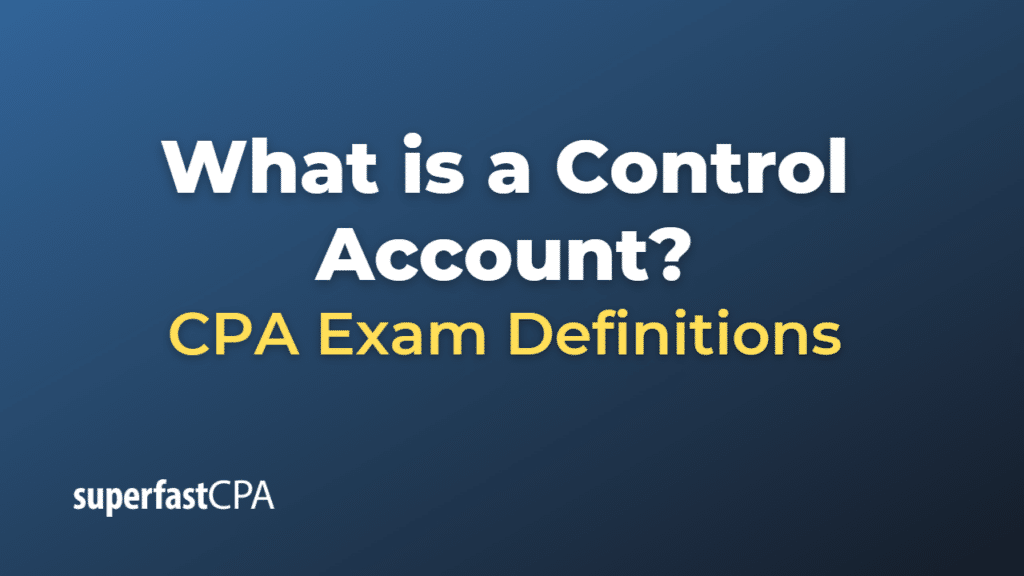Control Account
A control account, also known as a summary account, is a general ledger account that summarizes and consolidates the balances of multiple related subsidiary ledger accounts. Control accounts are used to simplify the process of tracking financial transactions and to ensure the accuracy of financial records by providing a high-level view of financial activities.
In double-entry bookkeeping, control accounts are typically used in conjunction with subsidiary ledgers. Subsidiary ledgers, sometimes called sub-ledgers, contain detailed records of individual transactions for specific accounts, such as accounts receivable, accounts payable, or inventory. Each subsidiary ledger is linked to a corresponding control account in the general ledger, which reflects the combined balance of all the individual accounts within the subsidiary ledger.
The purpose of control accounts is to:
- Simplify financial reporting: By summarizing the balances of multiple subsidiary ledger accounts, control accounts provide a streamlined, high-level view of financial activities, making it easier to prepare financial statements and reports.
- Ensure accuracy: Control accounts help maintain the accuracy of financial records by providing a point of comparison between the general ledger and subsidiary ledgers. Any discrepancies between the control account balance and the sum of the related subsidiary ledger balances can be quickly identified and investigated.
- Enhance internal control: The use of control accounts and subsidiary ledgers allows for a clear separation of duties, as different individuals may be responsible for recording transactions in the subsidiary ledgers and maintaining the control accounts in the general ledger. This separation of duties can help prevent errors and detect fraudulent activities.
Examples of common control accounts include:
- Accounts Receivable Control Account: This account summarizes the balances of all individual customer accounts within the accounts receivable subsidiary ledger.
- Accounts Payable Control Account: This account consolidates the balances of all individual supplier accounts within the accounts payable subsidiary ledger.
- Inventory Control Account: This account reflects the total value of inventory items recorded in the inventory subsidiary ledger.
In summary, a control account is a general ledger account that summarizes and consolidates the balances of multiple related subsidiary ledger accounts. Control accounts are used to simplify financial reporting, ensure the accuracy of financial records, and enhance internal control within an organization.
Example of a Control Account
Let’s consider a hypothetical example of a small business that uses control accounts and subsidiary ledgers to manage its accounts receivable.
The company has three customers: Customer A, Customer B, and Customer C. The business tracks the individual transactions and outstanding balances for each customer in an accounts receivable subsidiary ledger. The general ledger contains an Accounts Receivable Control Account that summarizes the total outstanding balances for all customers.
Here’s a summary of the outstanding balances for each customer:
- Customer A: $2,000
- Customer B: $3,500
- Customer C: $4,500
The Accounts Receivable Control Account in the general ledger should reflect the combined balance of all three customer accounts:
Accounts Receivable Control Account balance = $2,000 (Customer A) + $3,500 (Customer B) + $4,500 (Customer C) = $10,000
By comparing the balance in the Accounts Receivable Control Account ($10,000) with the sum of the individual customer balances in the accounts receivable subsidiary ledger ($10,000), the business can confirm the accuracy of its financial records.
Now, let’s say the company receives a payment of $1,500 from Customer B. The payment would be recorded in the accounts receivable subsidiary ledger, reducing Customer B’s outstanding balance to $2,000 ($3,500 – $1,500). The Accounts Receivable Control Account in the general ledger would also be updated to reflect the new combined balance:
Accounts Receivable Control Account balance = $2,000 (Customer A) + $2,000 (Customer B) + $4,500 (Customer C) = $8,500
In this example, the control account and subsidiary ledger system allows the business to maintain accurate financial records by providing a high-level view of accounts receivable activities in the general ledger, while still tracking the details of individual customer transactions in the subsidiary ledger. This setup also supports a clear separation of duties, as different individuals can be responsible for recording transactions in the subsidiary ledger and maintaining the control account in the general ledger.













